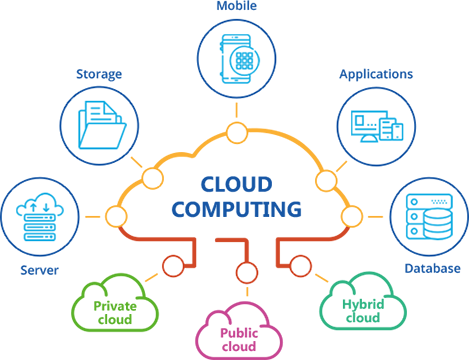Stay Upgraded with the Cloud Services Press Release: Trends and Advancements
Stay Upgraded with the Cloud Services Press Release: Trends and Advancements
Blog Article
Achieve Seamless Scalability With Cloud Services
In the ever-evolving landscape of cloud services, achieving seamless scalability stands as a keystone for modern services looking for to stay affordable and adaptable. The mission for smooth scalability with cloud services introduces a world of opportunities for those eager to embrace the transformative power of vibrant resource administration.
Advantages of Cloud Scalability
Cloud scalability offers organizations the adaptability to dynamically adjust sources based on need, making certain ideal efficiency and cost efficiency. One crucial benefit is the capability to range sources up or down quickly in reaction to changing work. This dexterity makes it possible for businesses to meet altering client needs without over-provisioning sources, ultimately bring about set you back financial savings. Scalability also boosts performance by ensuring that systems can deal with increased website traffic or work without experiencing downtime or slowdowns. By effectively designating sources, companies can keep high levels of efficiency throughout peak times without unneeded costs throughout quieter durations. Furthermore, cloud scalability advertises development and experimentation by enabling organizations to easily check originalities and range them as required. This adaptability urges a society of constant enhancement and adjustment, making it possible for companies to remain competitive in a swiftly evolving market landscape. Eventually, the advantages of cloud scalability extend past expense financial savings to incorporate improved efficiency, agility, and innovation.
Secret Features for Scaling
Effective scaling in cloud services depends on crucial functions that make it possible for organizations to change resources dynamically based on need. Another crucial attribute is scalability, making it possible for systems to manage boosted workload by adding resources perfectly. In general, these essential attributes jointly equip organizations to accomplish smooth scalability in cloud solutions.
Implementing Auto-Scaling Strategies
To efficiently optimize source allocation and adapt to differing work, companies have to purposefully execute auto-scaling strategies in their cloud services infrastructure. Auto-scaling allows systems to immediately change the variety of calculate resources based on real-time demand. There are numerous auto-scaling approaches that companies can utilize, such as anticipating scaling, which makes use of historic data to anticipate future resource needs, and responsive scaling, which replies to existing work changes.

Ideal Practices for Scalability
For companies aiming to boost their scalability in cloud solutions, executing best techniques is critical for optimum efficiency and resource monitoring. One secret best technique is developing applications with a microservices design. This method breaks down applications into smaller sized, independent services that can be released, updated, and scaled independently, enabling higher flexibility and scalability.
Another essential practice is using containerization technology, such as Docker or Kubernetes. Containers make it possible for the packaging of applications and their dependences into separated devices, making it simpler click to read to scale components individually and deploy them continually across various environments.
Furthermore, implementing automated implementation and infrastructure as code (IaC) can enhance scalability initiatives (linkdaddy cloud services). Automation tools like Terraform or Ansible assistance in provisioning and managing sources efficiently, lowering hand-operated mistakes and making it possible for fast scalability
Furthermore, monitoring performance metrics, establishing up notifies, and performing regular capacity preparation are vital practices to guarantee proactive scalability administration. By adhering read what he said to these best techniques, companies can attain seamless scalability in their cloud services while enhancing efficiency and source application.
Monitoring Performance Metrics
When evaluating the efficiency of cloud solutions scalability, very closely keeping track of performance metrics is crucial for making certain ideal capability and source appropriation. By continually tracking vital efficiency signs (KPIs) such as action times, throughput, source, and latency usage, companies can gain important understandings right into the health and performance of their cloud infrastructure. Monitoring performance metrics allows for the early discovery of potential bottlenecks or issues that could affect scalability, making it possible for proactive measures to be required to resolve them before they rise.

Final Thought
In final thought, accomplishing seamless scalability with cloud solutions is important for organizations to maximize performance, enhance innovation, and keep high efficiency levels during peak times. By leveraging the advantages of cloud scalability, executing auto-scaling techniques, utilizing key features such as elasticity and automation, and following best practices like application style and performance tracking, services can successfully scale their systems while making the most of source use and performance.
The quest for smooth scalability with cloud solutions introduces a globe of possibilities for those prepared to accept the transformative power of dynamic resource management.
Cloud scalability uses organizations the flexibility to dynamically readjust sources based on need, making certain optimum efficiency and price efficiency. Another key feature is scalability, allowing systems to manage raised work by adding sources perfectly.For companies aiming to boost their scalability in cloud services, carrying out best methods is crucial for ideal efficiency and resource monitoring.When evaluating the performance of cloud services scalability, carefully monitoring performance metrics is crucial for guaranteeing optimum functionality and source allotment.
Report this page